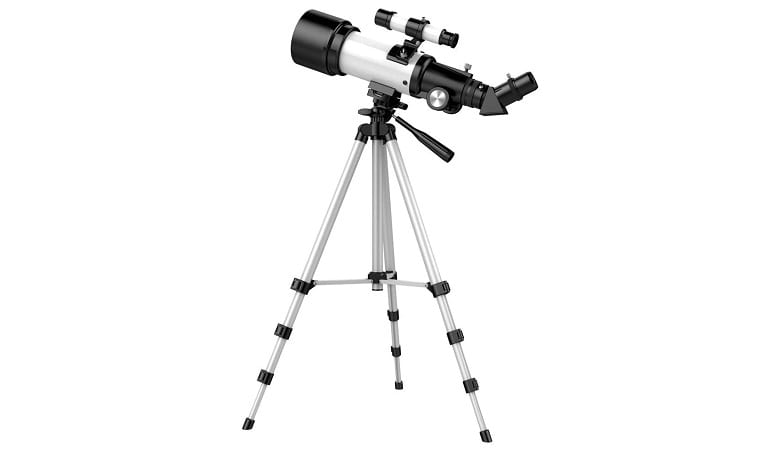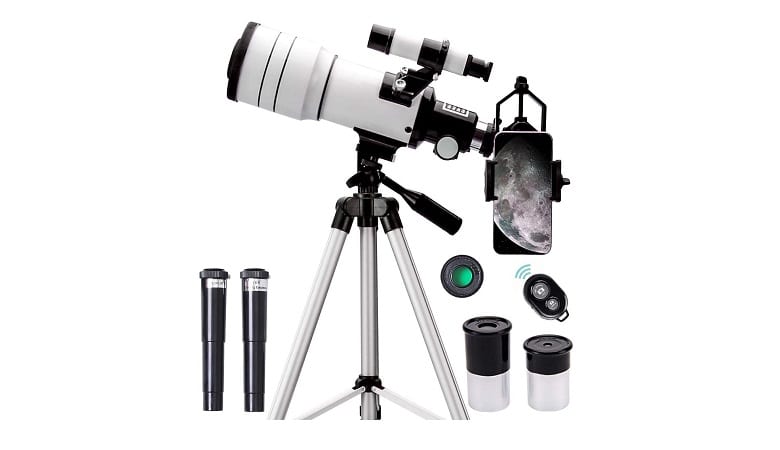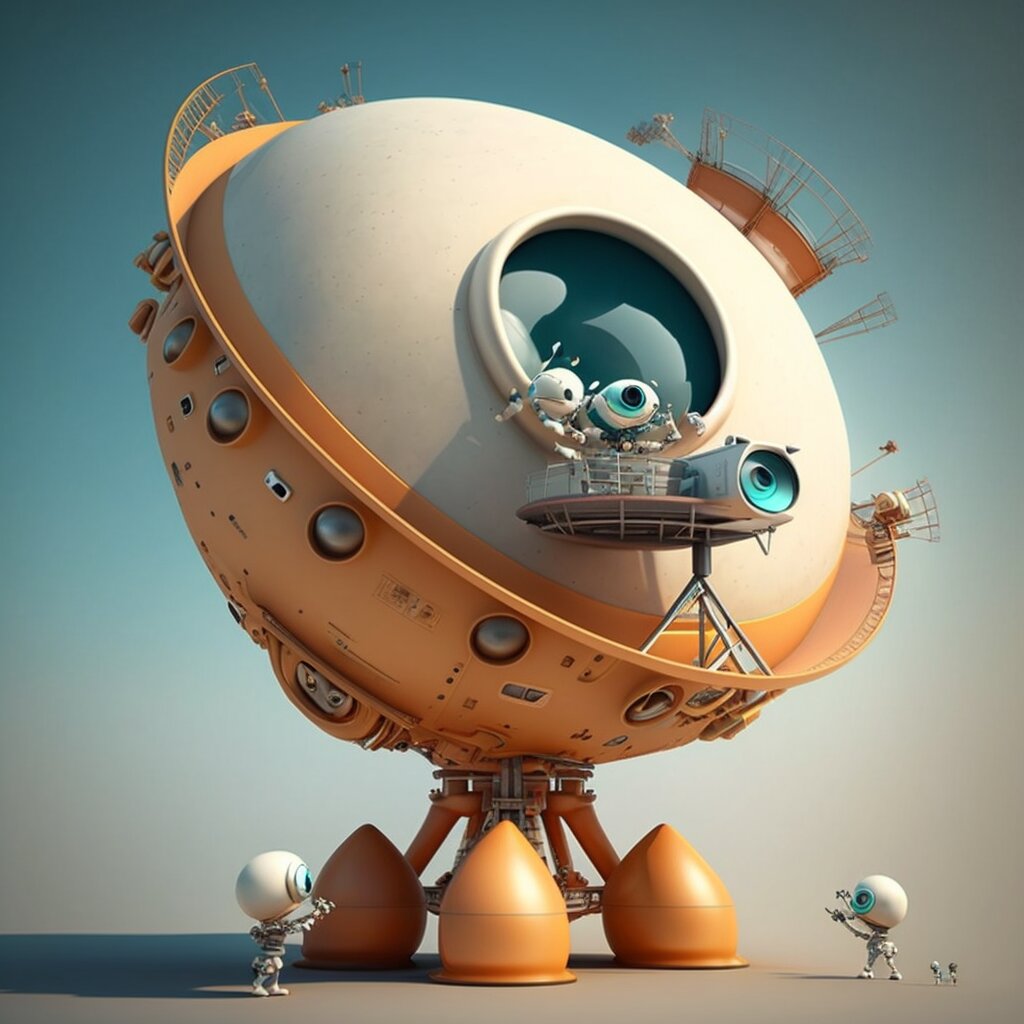If your child always tugs your arm and asks you to point out the stars, you’ve probably got the idea by now that they’re interested in astronomy.
Instead of just teaching them about the stars and galaxies via internet searches or by pointing out some stars you can see from your backyard, take their learning experience to a much higher level.
Make them have more fun while they learn by buying them a telescope as this will ensure they can get much better and more detailed views of celestial objects.
Aren’t telescopes expensive, though?
As a parent, you’re probably worried about the price of telescopes, especially if you fear that your child will lose interest after a few days of using them and then leave them to collect dust, but telescopes for kids don’t have to be costly.
In addition, by choosing the best telescope for your child, you’ll be able to keep them mentally stimulated so that their love of astronomy becomes a lifelong hobby.
Even if it doesn’t, it’s sure to increase their knowledge of, and passion for, planets, nebulae and other celestial beings. Here’s our guide to the best telescope for kids 2020: expand their view of the universe and give them memories they’ll always cherish.
Best Telescope For Kids – Reviews & Buying guide for 2020
Best Overall: Celestron Portable Refractor Telescope
Your kids will love this telescope, but we can’t guarantee that you won’t use it more than they do! That’s because it’s packed with lots of features that both children and adults will love.
Featured specs
- 70mm aperture
- Steel tripod
- Free travel bag
Benefits
- This telescope comes with two eyepieces that will provide your kids with various views of celestial objects.
- Celestron has given this telescope model of theirs an improved aperture of 70mm, which is an upgrade from the 50mm they used on other models. This enables your children to see more detailed and brighter images.
- Setting up the telescope is easy, so you won’t have to hassle or watch your children become bored during the process.
- This telescope has a panhandle to make it easier and more comfortable for your kids to search the sky.
- It comes with a mount that attaches to a steel tripod. It’s adjustable so you can make it lower to better accommodate your child’s height.
Drawbacks
- While the telescope is good, some people have reported complaints when it comes to the tripod, namely that it’s not sturdy enough. This can make it a bit tricky to use, especially for young kids.
- Others have said that the tripod should have knobs instead of a dial on it as the dial rolls back when adjusted.
- The product is mostly made of plastic, which has been off-putting for some parents.
Extra Features
- The telescope not only comes with a tripod, but also free software your kids will enjoy and a backpack so your kids can carry the telescope around much easier.
- This is a telescope that isn’t reserved for stargazing. You and your kids can also use it to view animals in the wild, thanks to its fully-coated glass optics. This makes the telescope much more versatile and practical for your kids to use in a variety of situations.
- You can make use of Celestron’s how-to videos if you get stuck at any time when using this telescope, which is a useful feature, especially if you’ve never used a telescope before.
Buying Advice
If you want to spoil your kids with a telescope, this one is a great choice. It has some great features that will encourage your children to use it, whether for seeing the environment around them in new ways or getting a deeper look into the skies that they won’t find in a textbook.
Runner Up: OYS Refractor Telescope
This telescope gives your children everything they need to become more interested in celestial objects, such as by providing detailed images of the moon! Here’s what to know about it.
Featured specs
- 20x and 40x magnification
- Diagonal prism
- K20mm eyepiece
Benefits
- This refractor telescope has 70mm of aperture, which is great for kids and beginners, but it also has two eyepieces that you can use for 20x and 40x magnification.
- In addition to the eyepieces, this telescope has a 5×25 finder scope. This helps you to find celestial objects much easier.
- The included diagonal prism means that you’ll get upright images of celestial objects.
- The telescope comes with a cell phone adapter included, so your kids can share their images.
- It’s nice to give your children a telescope that they’ll be able to use for more than just one type of activity and this one has that covered just like the previous product because you can use it during the daytime, such as when you want to take your kids on a birdwatching trip.
- You’ll love letting your kids see the moon in a new and exciting way, thanks to the K20mm eyepiece that provides detailed and breathtaking imagery. Your children will see the moon and other planets in ways they’ve never seen before.
Drawbacks
- There are no clear instructions for using the telescope, which some people have reported is a disadvantage.
- Some people have reported that using the telescope with their smartphone isn’t easy to do.
- The tripod is said to be very unstable and wobbly, which proves problematic when you’re trying to align it.
Extra Features
- There are a lot of goodies included in the pack, such as a travel backpack and an aluminum alloy tripod.
- People have said that assembling and setting up this telescope takes less than five minutes! That means less time trying to get it to work and more time enjoying how it works.
Buying Advice
This is great telescope for kids. It’s an affordable and valuable telescope which won’t be a hassle to set up. It’s also extremely portable so you can take it on all your family adventures without a hassle.
Alternative: TELMU Astronomical Refracting Telescope
This TELMU telescope is a nice alternative if you’re looking for a product that has a few extra features to make using a telescope a more comfortable experience for your kids.
Featured specs
- 360-degree views
- Fully-coated optics lens
- Bionic tripod
Benefits
- This refractor telescope offers 360-degree views, enabling you to rotate the telescope so that you get a richer experience.
- It has an aperture of 70mm while containing a fully-coated optics lens. This not only creates brighter, more defined images, but it also protects your vision.
- It has a 5×24 finderscope that has a mounting bracket to help you better find objects in the sky.
- Your kids will love being able to take pictures or videos and then share them with all their friends, thanks to the phone adapter that’s included.
- The tripod is stable and secure, thanks to its bionic design and hoof shape.
- The telescope makes use of a 45-degree diagonal mirror. This makes it more comfortable to view images when the telescope is pointed at something directly overhead.
Drawbacks
- Some people have reported that this telescope mount could be better designed. One of the issues with the mount that’s been mentioned is that the part which screws into the telescope hasn’t been properly aligned so that it can be efficiently used with the adjustment lever.
- People have also stated that the phone adaptor is difficult to use.
- This telescope is currently unavailable on Amazon.
Extra Features
- This telescope comes with a carrier bag.
- It also comes with two 1.25-inch Kellner eyepieces that are replaceable. These are considered to be great for stargazing beginners.
Buying Advice
This is the best telescope kit for kids who want to learn more about the universe.
Best Budget Telescope For Kids: ToyerBee Astronomical Refractor Telescope
Although this telescope is the cheapest one on our list so far, it was designed to help you see the moon’s craters, Saturn’s rings, and Jupiter’s major moons, which is sure to intrigue your kids.
Featured specs
- Adjustable tripod
- 3x Barlow lens
- Wireless camera remote
Benefits
- This telescope provides a large amount of magnification, thanks to its 3x Barlow lens as well as two eyepieces. The magnification ranges from 15x to 150x.
- The tripod is adjustable for greater convenience when viewing celestial objects. It can be adjusted from 16 inches to 46 inches.
- The telescope comes with a smartphone adapter as well as a wireless camera remote. This means you’ll be able to take pictures without touching your phone, which makes it much more convenient.
- This telescope can also be used as a terrestrial telescope that will enable you and your kids to see amazing views of valleys, mountains, and much more.
Drawbacks
- Since it’s a telescope for beginners, you won’t be able to attach a DSLR camera to it and take pictures of distant celestial objects.
- Since this telescope is a manual one, it isn’t as user-friendly as a computerized one. However, you might find that’s not the case.
Extra Features
- Like many other telescopes we’ve reviewed, this one has an aperture of 70mm.
- It’s easy to install and start using within 10 minutes and you don’t need any extra tools to complete the setup.
- Kids will enjoy making use of the telescope’s zoom feature that enables you to see details, such as the moon’s craters.
Buying Advice
This is a good telescope with many features while being easy to use. If you want to see if your kids will like using a telescope and remain interested in their stargazing hobby, this is a great one to buy because you won’t be blowing your budget on it.
Best Budget Telescope For Kids Runner Up: Little Experimenter Telescope for Kids
This telescope is quite different from others we’ve featured in our guide. It looks like a toy, but don’t let its appearance fool you because it’s got some great features. It’s a telescope and wall projector, which makes it an easy-to-use beginner telescope for kids.
Featured specs
- 3D detail
- Projection discs
- Soft eyepiece
Benefits
- This telescope can be swivelled around or locked in place, so your kids can easily adjust how they want to view the sky.
- It has 2x magnification so that you can explore the solar system with your children in stunning 3D detail.
- The tripod is foldable, which makes it easy to store and transport.
- It comes with projection discs that have 24 pictures of planets, spaceships, and more.
- One of the kid-friendly features of this telescope is that it comes with a soft eyepiece that shapes around the eyes to make viewing the galaxy much more comfortable.
Drawbacks
- One of the drawbacks of this telescope is that the projector needs to be within inches of a wall in order to display clear images.
- You can’t use this telescope outside to see the moon, stars, and planets because it’s not that advanced.
- Some parents who purchased this telescope reported that the tripod’s legs are too short, even for very young children to use.
Extra Features
- This Little Experimenter telescope comes with a guide book that’s filled with information, interesting facts, and activities related to the universe. It makes for a great learning adventure for your kids, which will surely make them want to learn even more about space.
- You don’t have to worry about your kids when they use this telescope for hours on end because it’s been 100 percent child safety certified.
- The telescope requires 3 LR44 batteries, but they are included with your purchase, so you won’t have to rush out and purchase them before seeing your kids’ eyes light up at the sight of the telescope.
Buying Advice
This Little Experimenter telescope is meant for kids who are eight years or older, but younger kids will probably enjoy it more. This is the best beginner telescope that’s a fantastic way to make them feel inspired and interested in astrology.
Kid Telescope FAQ
Now that you have a better idea of the type of telescope you’d love to buy for your kids, you might have some questions about telescopes. Let’s check them out.
How do I choose a telescope for kids?
Telescopes can seem pretty complicated if you’ve never bought one before, so when you purchase one for your child you want to ensure that it’s easy for them to learn and enjoy. Here are some important features to look for in the best telescopes for kids.
Keep The Eyepieces Simple
Although you might think that a telescope that has many accessories included in the pack will be more interesting, remember to take your child’s age into consideration.
If your kids are very young, having many accessories included with the telescope can start to make it feel too complicated. An example is eyepieces.
You want to ensure that the telescope has eyepieces with low magnification. These will help you view things like nebulae. However, it should also have a high magnification eyepiece so that your kids can see things, like the moon, in much more detail. But more than that is probably a waste.
Choose One With A Barlow Lens
This type of lens gets fastened to the telescope and if you attach it before you put the eyepiece on, you can increase the eyepiece’s magnification by double or triple, so it’s a useful accessory.
The ToyerBee telescope we featured in our telescope for kids reviews has this lens, so that model is worth considering.
Star Maps or Other Resources
Since your child wants to learn how to use their telescope and will enjoy learning about the solar system in the process, you should look for a telescope that provides extra resources, such as star maps (which are maps of the sky), software, or guides.
Look For A Quality Tripod
The tripod is one of the most important features when you purchase a telescope. No matter how good the telescope itself is, it needs to be on a stable surface in order for you to prevent blurry images and avoid frustration because of it’s dreadful wobbling.
An example of a telescope that comes with a quality tripod is the Telmu telescope tripod with its bionic design.
On the subject of tripods, it’s also a good idea to choose a tripod that can have its height adjusted so that when your child continues to grow, he or she will still be able to use the telescope comfortably.
Be Careful When Purchasing Toy Telescopes
While they can be fun, especially if they have a projector included like the Little Experimenter telescope we featured in our best telescope for kids reviews, you should ensure that toy telescopes which catch your eye online aren’t expensive.
This is because they’re usually meant for really young kids and are likely to be a fad. If your child is over the age of six, it’s probably best to purchase a fully-functional telescope that they’ll be able to use for a long time.
That said, if your child is very young and has expressed interest in star gazing, a toy telescope such as the Little Experimenter can be useful as a starter telescope and it doesn’t cost a lot of money.
Choose Refractor Over Reflector Telescopes
Both kinds of telescopes have their specific advantages, but refractors are focused on enabling you to view objects in the night sky as well as daytime scenes.
This makes them more versatile, which means they’re more likely to keep your child interested.
For example, it’s wonderful if the telescope can enable your child to view wildlife, mountains, and other spectacular things on earth, instead of just celestial objects at night.
What is a good strength for a telescope?
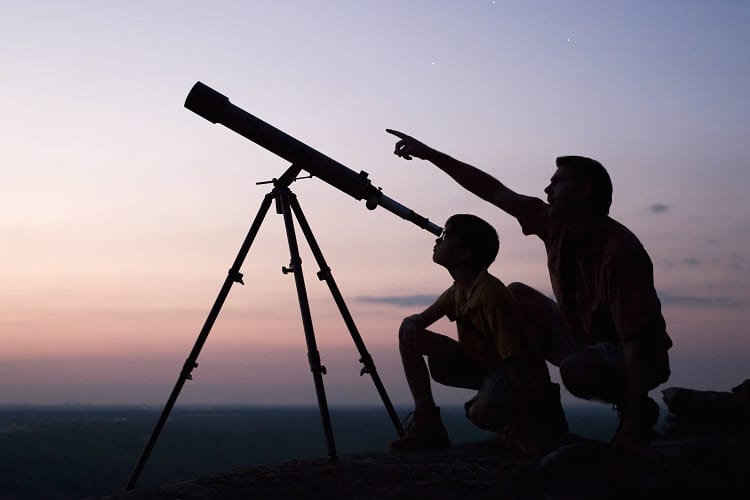
When it comes to telescope strength, or magnification, it’s easy to assume that more magnification is always better. But if you find a quality telescope that has slightly lower magnification than some others on the market, don’t let that be a deal-breaker.
Some telescope brands will try to sell you on the amazing magnification of their telescope, but if it’s too high – like 600x – that should be a red flag.
Here’s the lowdown on magnification that you need to know. Generally, a telescope’s maximum useful magnification is 50 times its aperture in inches, as Sky and Telescope reports.
That means that in order to benefit from a magnification of 600x, you’d require a telescope that’s 12 inches wide to provide good images.
Best type of telescope for kids
Earlier in this article, we looked at important tips to follow when searching for a quality telescope for your children. In our buying guide of the best telescopes for kids, it’s clear to see that there are some common features that should be present in a quality telescope.
For starters, the telescopes you choose should be really simple and easy to set up.
This is important because you want to avoid telescopes for kids that are complex – even for you! – as this is sure to cause kids to lose interest and go in search of other activities while you try to struggle your way through the setup process.
Although you might not like that your kids want to use their phones all the time, many of the best telescopes for kids will cater to their tech needs by making sure that they include smartphone adapters in the purchase.
This makes the activity of watching the night sky much more entertaining because kids will love being able to share their images with their friends.
There are also some important extra features that could be nice to have to make your child feel that the telescope is user-friendly. For example, a diagonal prism is good as it ensures that the pictures will be upright.
It also ensures that you can comfortably view images when the telescope is pointed up ahead. These types of features make the telescope much more accessible for children, but they’re not available in all children telescopes, so keep an eye out for them.
Ultimately, one of the biggest reasons why you might hesitate to purchase a telescope for your kids is if you think that they’ll get bored with it and will move on to some other activity or project after a few days or weeks, leaving the telescope to collect dust.
But this can be prevented by choosing a telescope for them that is versatile. As we’ve seen in our buying guides, you can find great telescopes for kids that can be used for a variety of activities, not just stargazing.
For example, they could be used for children who want to study birds or wildlife, which makes them fantastic to take along on a family adventure in the great outdoors.
Speaking of how your child will love carrying the telescope wherever they go, you’ll want to be sure that your children look after the telescope you purchase for them. That’s why you’ll need a bag for it.
Many of the top telescopes for kids have that covered as you’ll see in our reviews that they come with travel bags included. These can also be used to store the telescope safely at home when it’s not in use.
How powerful does a telescope have to be to see the rings of Saturn?
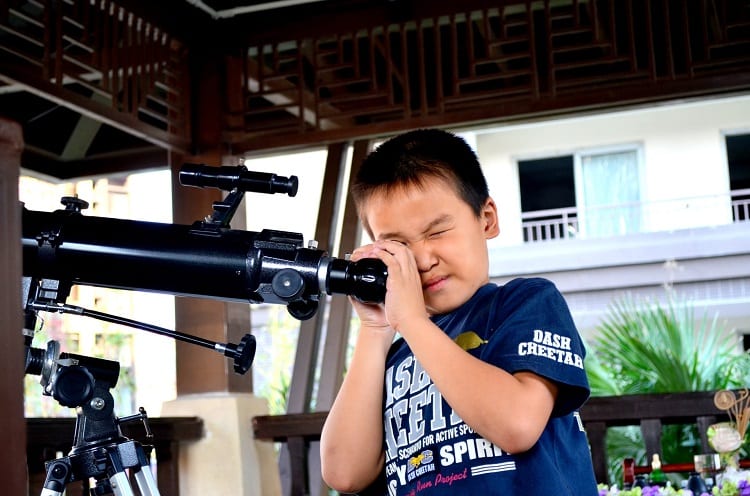
As we’ve seen in our buying guide, you can definitely find a telescope on the market that will enable you to see Saturn’s rings, which is pretty exciting. But how much power will that telescope require in order to achieve this?
Here’s what you need to know.
It might surprise you to find out that Saturn is actually really easy to find, even with a small telescope. This is because its rings will be visible with a telescope of 25x magnification.
If you use a three-inch telescope that’s got 50x magnification, this will enable you to see the rings as a separate entity on all sides from the ball of Saturn, as Sky and Telescope explains.
Of course, it’s always a good idea to ensure that visibility is good so that you can enhance the view.
Can you see planets with a cheap telescope?
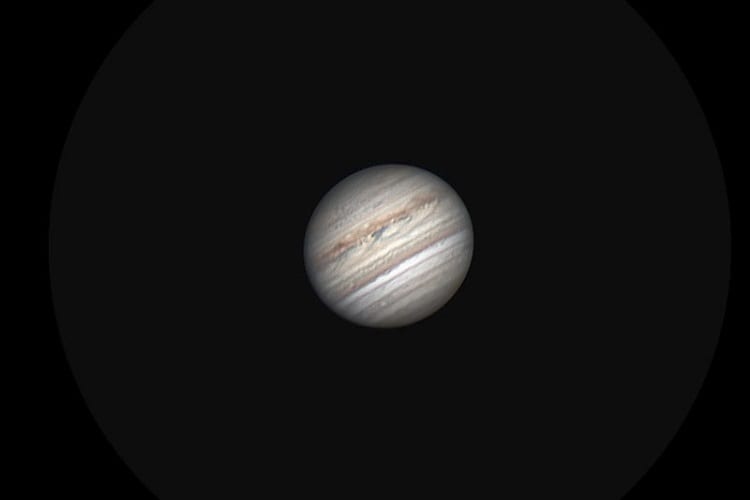
We’ve talked about Saturn’s rings, but what about seeing other planets?
Although you might think you need an expensive telescope in order to view the planets, this is a myth!
A small telescope will reveal interesting details on planets, and a medium-sized one will enable you to see Jupiter, Saturn, Venus, and Mars even under city lights.
Bear in mind that seeing planets will be easier if you try it with a small but high-quality 80mm refractor instead of a telescope that has a higher aperture but weak optics.
If you have color filters, using them when viewing certain planets is a good idea as they will ensure you get to see more details. This will also enhance your child’s star-gazing experience.
For example, a #47 violet filter will help you when viewing Venus, but make sure that you use it with a telescope that’s at least eight inches, as Astronomy reports. Similarly, to view Mars’s orographic clouds, you should use a #80A blue or #47 violet filter.
One of the easiest celestial objects to see through a telescope is the moon. You can see it at a low magnification and it’ll look pretty much the same as what you’d see with higher magnification.
The only difference is that if you purchase a telescope that’s of a higher quality, this will give you more details and you’ll be able to zoom into it.
That said, there are telescopes for kids that will enable you to make use of the zoom feature, such as the ToyerBee telescope that we featured in our reviews.
If you want a guide to help you know the best times when to search for specific planets so that you increase your chances of finding them, you should check out this guide by Sky At Night. It provides you with the best times in which to view various planets during different months of the year.
Conclusion
Telescopes are a fantastic gift for your children as they will enable them to broaden their horizons and learn more about our amazing world. If you’re tempted to purchase a telescope for them, you might worry that they’re complicated and too expensive.
However, they really don’t need to be. Companies that sell telescopes have made them much more accessible, even to kids.
In this buying guide, we’ve featured five of the best telescopes for kids. We’ve looked at their benefits, drawbacks, and costs so that you can choose the one that will keep your children mentally stimulated and excited to learn. Who knows?
They might be budding astronauts!


